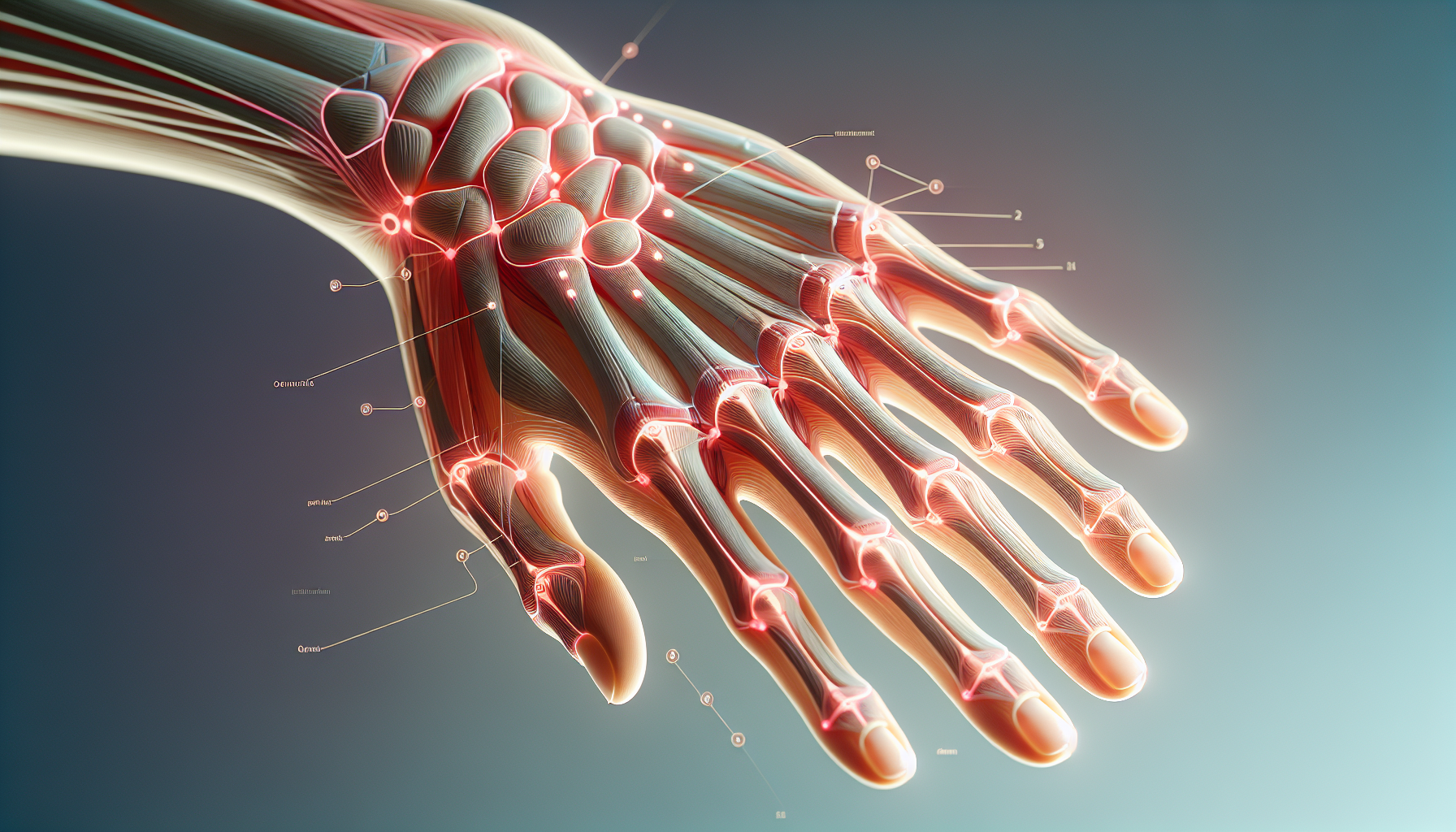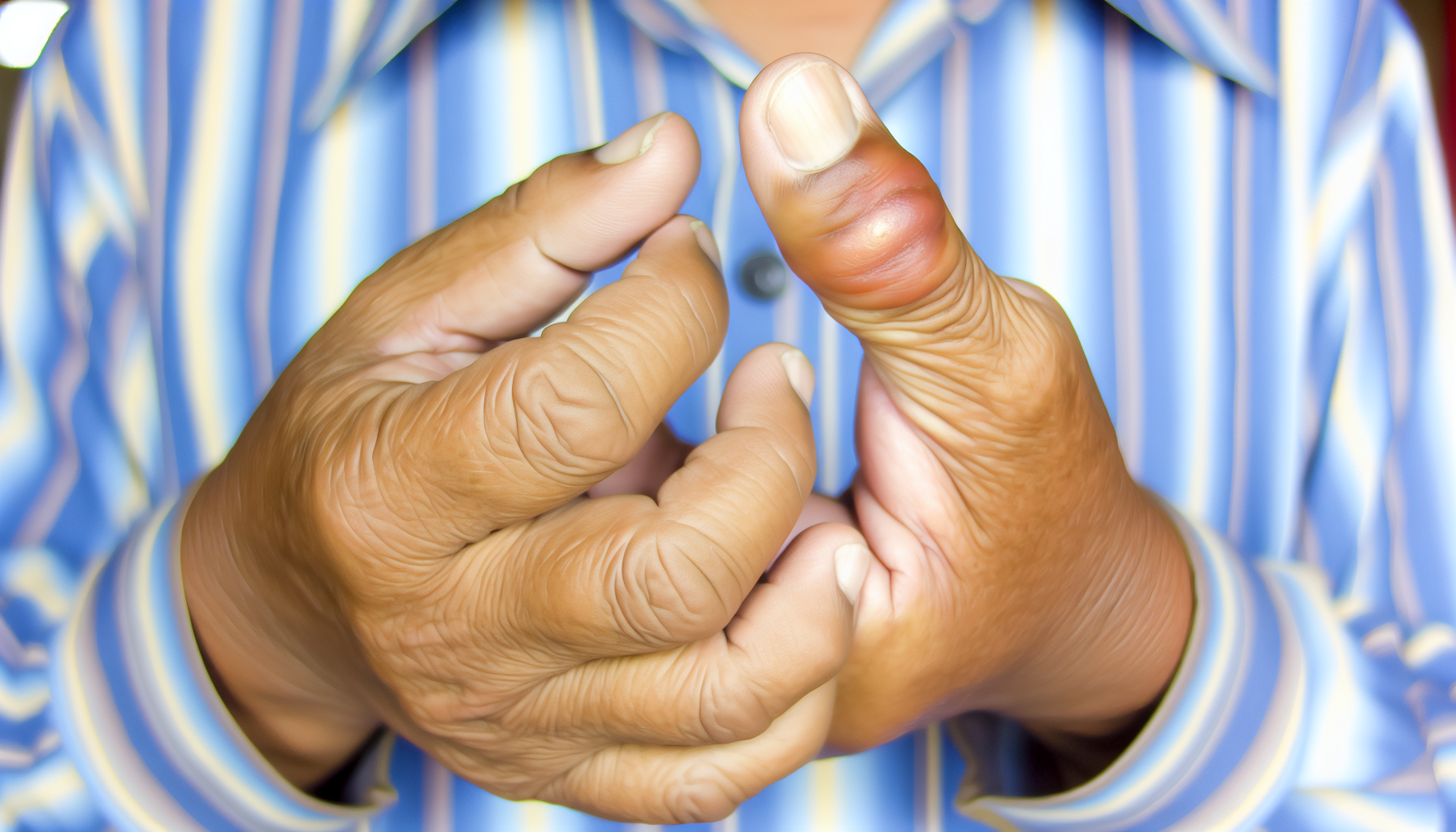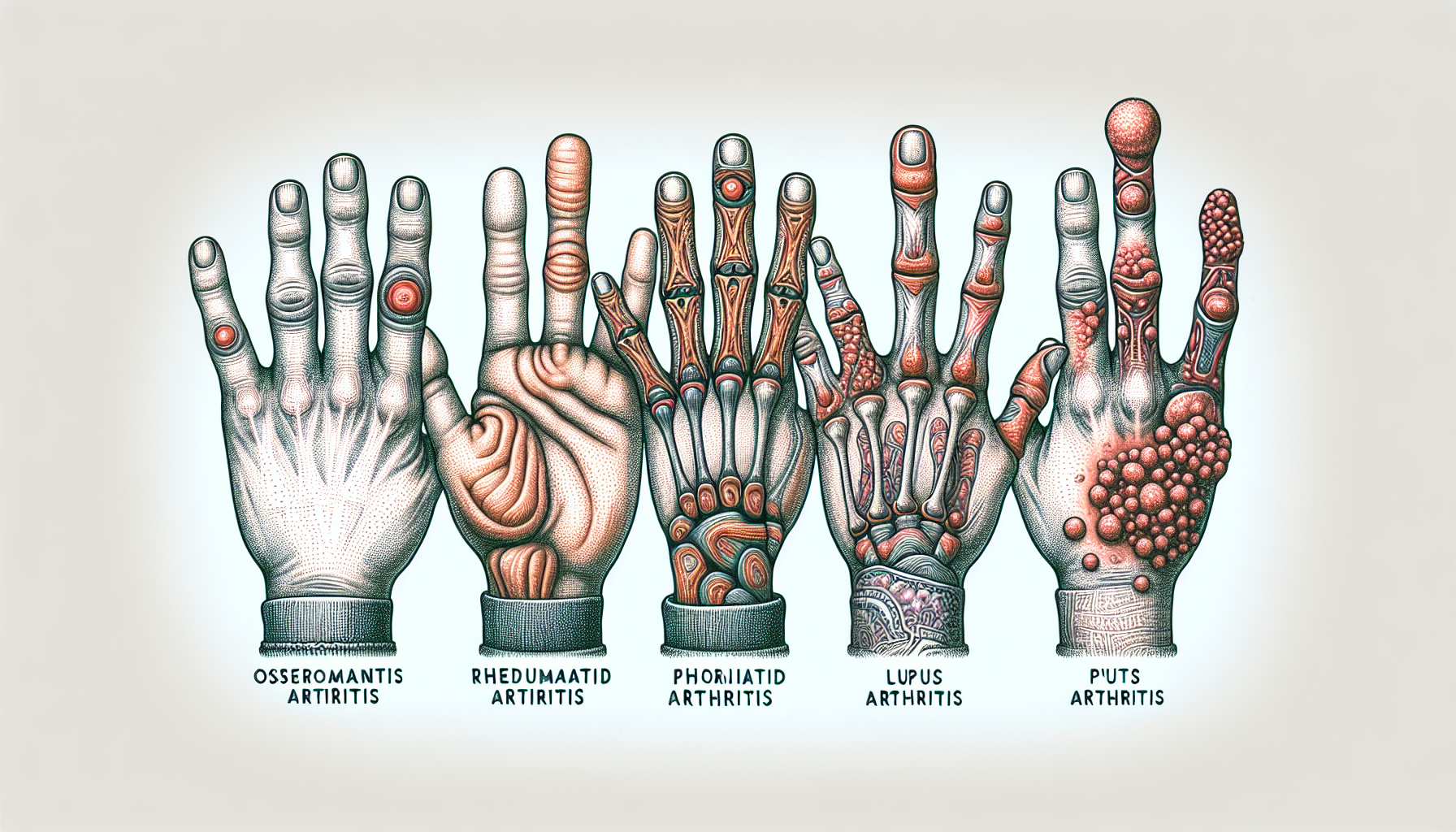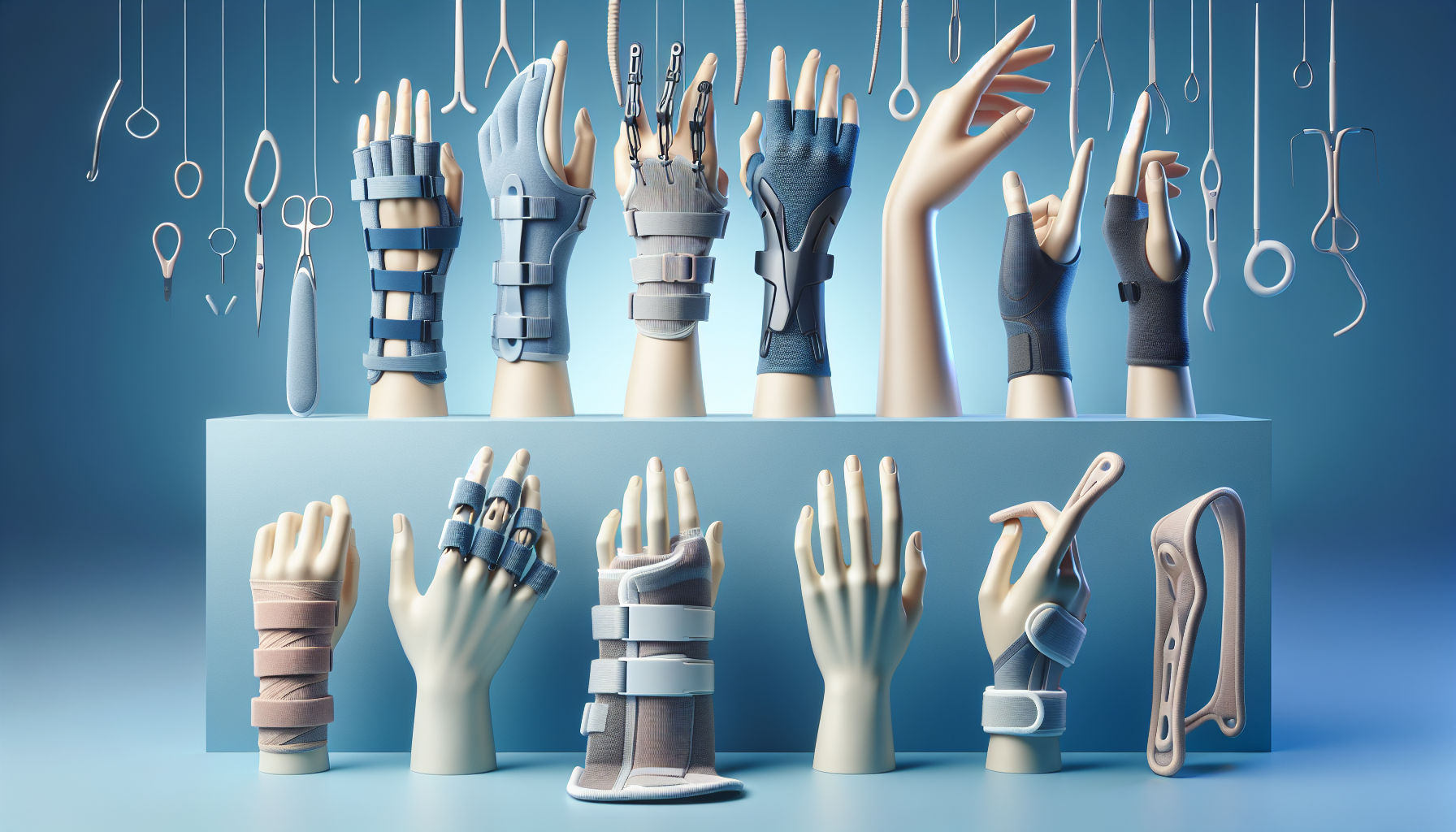Early Arthritis in Fingers: Recognizing Symptoms and Taking Action
Stiffness, swelling, or pain in your fingers could signal early arthritis, a condition that shouldn’t be ignored. This guide will help you spot the signs of early arthritis in fingers, understand its impact, and take the right steps towards effective management.
Key Takeaways
- Early signs of finger arthritis include pain, stiffness, swelling, and joint deformity; recognizing these symptoms is crucial for timely treatment and management of the disease.
-
Arthritis in the fingers can be due to various types, particularly osteoarthritis and rheumatoid arthritis, each requiring specific management strategies.
-
Effective early treatment options for arthritis in the fingers include CBD and supplements, dietary changes, medications, physical therapy, and lifestyle adjustments; severe cases may require assistive devices or surgery.
Recognising Early Signs of Arthritis in Fingers

Timely management of arthritis hinges on recognizing its early signs in the fingers. Other symptoms such as:
-
pain
-
stiffness
-
swelling
-
joint deformity
Recognizing the early signs of arthritis can indicate the onset of this condition. Arthritis affects the small joints in our hands and understanding these signs can make a significant difference in managing the progression of the disease, especially in the affected joints.
The first signs often manifest as discomfort in the finger joints, which may become more frequent as arthritis progresses. This discomfort can disrupt simple daily activities, making tasks like opening jars or turning keys increasingly difficult. Grasping these symptoms and promptly seeking medical advice paves the way for effective treatment.
Pain and Stiffness
Pain and stiffness in the finger joints are key indicators of arthritis, often manifesting as joint pain. This pain can appear in various forms, including a dull ache or a sharp burning sensation. It often escalates as the cartilage in the joints wears down, leading to increased disruption and damage.
Stiffness, another common symptom, can worsen during periods of inactivity. This may make mornings particularly challenging, as the joints become stiff and painful after a night of rest, leading to morning pain. Comprehending these symptoms and their relation to arthritis progression is key in pursuing suitable treatment.
Swelling and Joint Deformity

Swelling and joint deformity are also clear indicators of arthritis. Swelling occurs when the affected joint is subjected to more stress than it can bear. This can lead to visible changes in the fingers, such as bony lumps or a crooked appearance.
Joint deformity can occur due to:
-
Accumulation of inflammatory cells within the joint lining
-
Bone erosion
-
Cartilage destruction
-
Ligament damage
-
Joint fusion
These changes can result in visible alterations to the normal shape of the fingers and reduced mobility.
Types of Arthritis Affecting Fingers

Arthritis is not a single disease but a term that encompasses various conditions affecting the same joints, including dip joints and middle joint. The two most common types that impact the fingers and thumbs are osteoarthritis and rheumatoid arthritis.
Osteoarthritis is characterized by the deterioration of cartilage in the finger joints, often affecting the joint nearest to the fingertip. On the other hand, rheumatoid arthritis is an autoimmune condition that targets the joints, usually sparing the joint closest to the fingertip. Knowing these types and their unique characteristics can aid in customizing effective treatment strategies.
Risk Factors and Prevention
There are several risk factors that can increase the likelihood of developing finger arthritis. These include:
-
Genetics: Research indicates a significant genetic involvement in hand osteoarthritis.
-
Age: The risk increases as we get older, although aging does not necessarily guarantee arthritis.
-
Past injuries: Previous hand injuries can contribute to the development of finger arthritis.
-
Lifestyle choices: Factors such as occupation, repetitive hand movements, and obesity can also increase the risk of finger arthritis.
Preventing finger arthritis involves managing these risk factors. Maintaining a healthy weight, engaging in regular exercise, and minimizing repetitive stress on the finger joints can contribute to overall joint health and decrease the probability of developing arthritis.
Diagnosing Finger Arthritis
Diagnosing finger arthritis is a comprehensive process that involves:
-
A discussion about the symptoms
-
A physical examination of the hands to identify any atypical changes such as deformities or nodules
-
Several diagnostic tests
Additional tests such as X-rays, MRI scans, and blood tests may be requested to confirm the diagnosis. These tests can reveal signs of joint damage, inflammation, and other markers of arthritis, helping doctors determine the type and severity of the condition.
Early Treatment Options
Once a diagnosis is made, early treatment can begin. This often involves a combination of:
-
CBD and other supplements
-
Dietary changes
-
Medications
-
Physical therapy
-
Lifestyle modifications
These treatment options aim to manage symptoms and slow the progression of the disease.
Bear in mind that initiating treatment early is vital. Starting the treatment sooner enhances its potential effectiveness in slowing down disease progression and preserving joint function. Now, let’s delve deeper into each of these treatment options.
CBD and other supplements
CBD and other supplements, such as glucosamine and chondroitin, are frequently used in the early stages of finger arthritis. CBD, in particular, is gaining popularity due to its potential anti-inflammatory properties. There are anecdotal reports of individuals experiencing noticeable pain relief, improved sleep, and reduced anxiety after using CBD.
Nonetheless, it’s worth noting that the evidence backing the effectiveness of CBD and other over-the-counter supplements is sparse. As a rule of thumb, discussing any new treatment plan with your healthcare provider is advised.
Its also worth mentioning that there is a gulf of class between the quality of cbd products a ipanle on the market - we only advocate the use of full spectrum oils, which offer the most potential benefit due to the many compounds working together to bring a greater level of relief. See here for our recommended product for joints.
Diet
Dietary changes can make a significant impact on the management of arthritis symptoms. A diet rich in omega-3 fatty acids, fruits, vegetables, whole grains, and fish can help manage inflammation and symptoms.
Reducing the consumption of red meat and processed foods in favor of poultry, fish, and whole grains can also be beneficial. Staying hydrated by consuming ample water is also essential. A nutritionist can provide personalized dietary recommendations to help manage arthritis symptoms.
Medications
Medications are a cornerstone of arthritis management. They include analgesics, nonsteroidal anti-inflammatory drugs (NSAIDs), and corticosteroids. These medications work by managing pain and inflammation, thereby improving function and quality of life.
Note that even though these medications can alleviate symptoms, they don’t slow down disease progression. Hence, they’re frequently used alongside other treatment strategies for effective arthritis management.
Physical Therapy

Physical therapy plays a key role in managing arthritis symptoms. Hand exercises and heat/cold therapy can help maintain flexibility, reduce pain, and improve function in the affected fingers. Regular exercise can reduce pain, stiffness, and swelling in the fingers by improving joint flexibility.
In addition to exercises, hot/cold therapy can also be beneficial. Heat therapy can relax muscles and aid in joint lubrication, while cold therapy can reduce inflammation and provide pain relief. A physical therapist can provide personalized therapy plans to help manage arthritis symptoms.
Lifestyle Changes
Lifestyle changes are an important part of managing arthritis symptoms, including those of psoriatic arthritis. Stress reduction, regular physical activity, and proper hand ergonomics can help manage symptoms and prevent further joint damage.
Stress reduction can lower the body’s inflammatory response, thus helping to manage pain and swelling. Regular physical activity can improve joint flexibility and overall health. Proper hand ergonomics can prevent additional stress on the joints, thereby reducing the risk of exacerbating symptoms and joint damage.
Assistive Devices and Support

Assistive devices can provide much-needed support and relief for individuals with arthritic fingers. Splints, braces, and compression gloves can prevent finger bending, stabilize the finger, improve alignment, and relieve pain caused by movement.
Despite their potential for immediate relief, these devices must be used with caution. Long-term use can result in stiffness and muscle weakness over time. Therefore, discussing their use with a healthcare provider is recommended to ensure safe and effective usage.
When to Consider Surgery
In severe cases of finger arthritis, when conservative treatments fail to provide adequate relief, surgery may be considered. Surgical options include:
-
Joint preservation
-
Reconstruction
-
Fusion
-
Joint replacement
Each of these procedures has its own set of benefits and risks, and the choice of procedure depends on the type and severity of arthritis, the patient’s overall health, lifestyle, and personal preferences. Having an in-depth discussion with your healthcare provider to understand the potential outcomes is essential for making an informed decision.
Emerging Treatments and Research
The field of arthritis treatment is constantly evolving, with new treatments and research emerging frequently. These include new medications, stem cell therapy, and gene therapy, which may offer promising alternatives for managing and treating finger arthritis in the future.
While these treatments are still in the experimental stages, they hold great promise for the future. They represent a significant advancement in our understanding of arthritis and our ability to manage this condition effectively.
Summary
In conclusion, arthritis in the fingers is not an inevitable part of aging, but a condition that can be managed effectively with early detection and prompt intervention. By recognizing early signs, understanding risk factors, and taking proactive steps, you can significantly improve your quality of life. Remember, you’re not alone in this journey, and there are numerous resources and support systems available to help you manage this condition effectively.
Frequently Asked Questions
What does early arthritis in fingers feel like?
Early arthritis in the fingers can feel like stiffness, limited movement, and difficulty in grasping objects due to reduced range of motion. It may also cause pain, swelling, and the development of bumps on the finger joints, with the pain potentially decreasing over time.
What age does arthritis start in fingers?
Arthritis in the fingers typically starts to appear after the age of 50, with rheumatoid arthritis usually manifesting between 35 and 50.
What foods aggravate arthritis?
Processed meats, refined carbohydrates, dairy products, alcohol, and tobacco can aggravate arthritis. Red meat, fried foods, and foods high in omega-6 fatty acids should also be avoided. All these foods can worsen arthritis symptoms and should be limited in your diet.
What is the best pain reliever for arthritis in hands?
The best pain reliever for arthritis in hands is nonsteroidal anti-inflammatory drugs (NSAIDs), such as ibuprofen, diclofenac, naproxen, and celecoxib, which reduce pain and swelling in affected joints. Analgesics like acetaminophen (Tylenol) and opioids are also commonly used for pain relief.
What are the symptoms of osteoarthritis in the hands?
The symptoms of osteoarthritis in the hands include pain, stiffness, reduced range of motion, tenderness when pressing the affected joint, and difficulty with tasks and reduced grip strength. Additionally, as arthritis progresses, individuals may experience crepitus, with damaged joint surfaces causing grinding, clicking, or cracking sensations.
